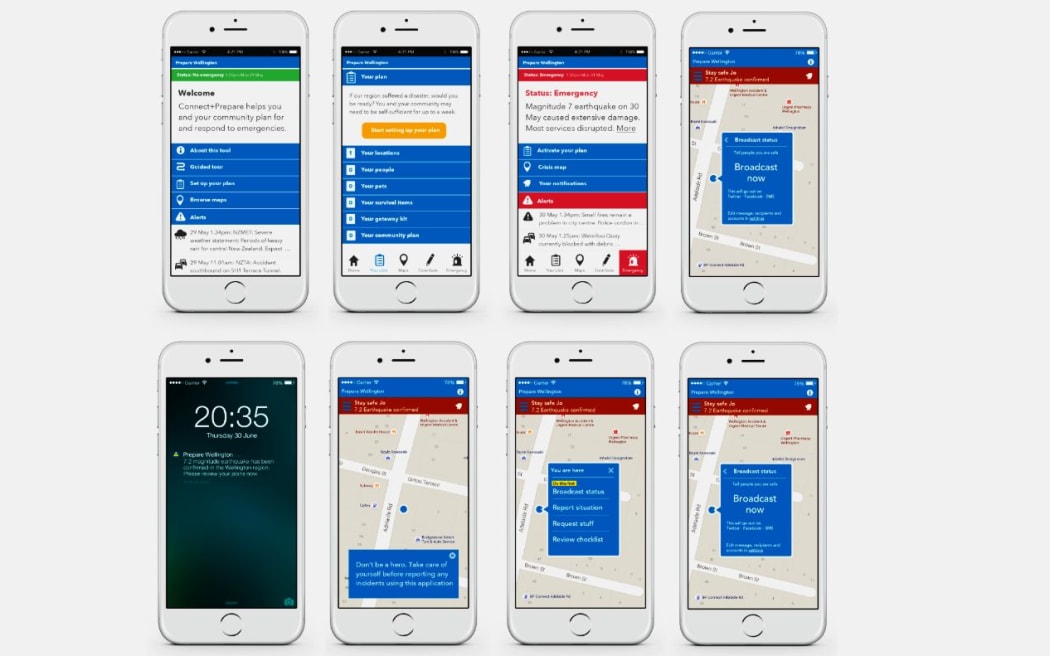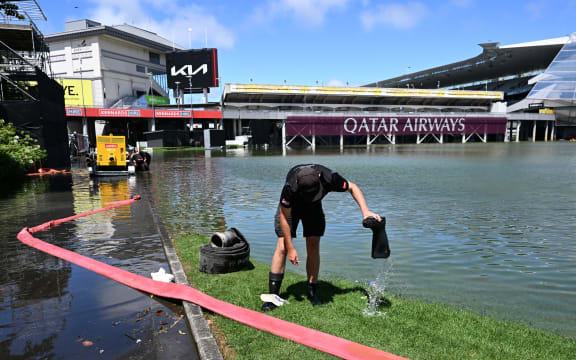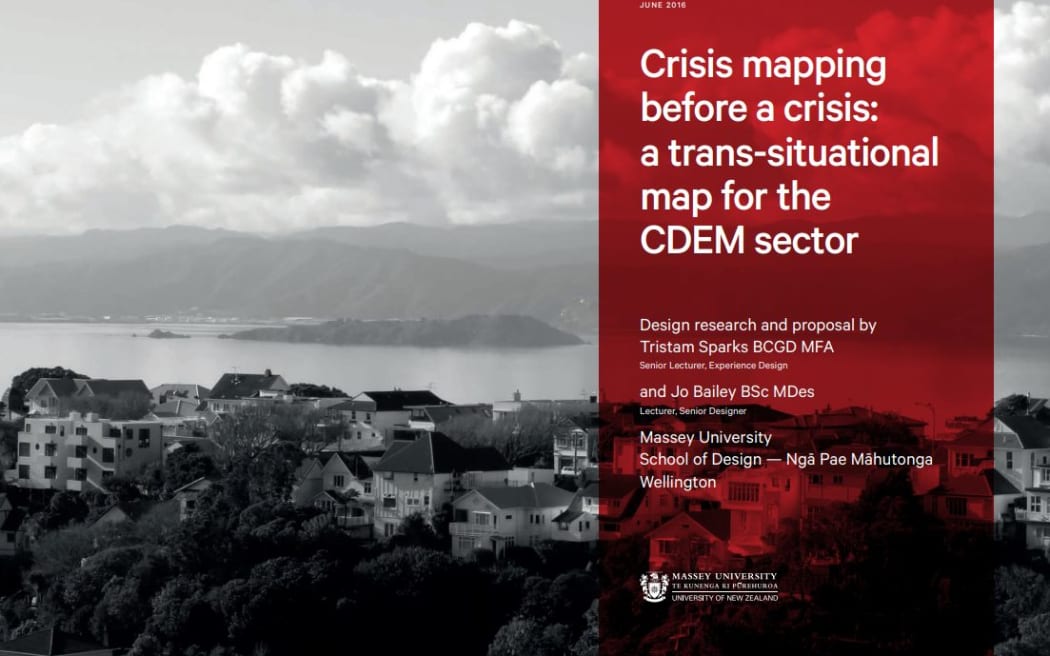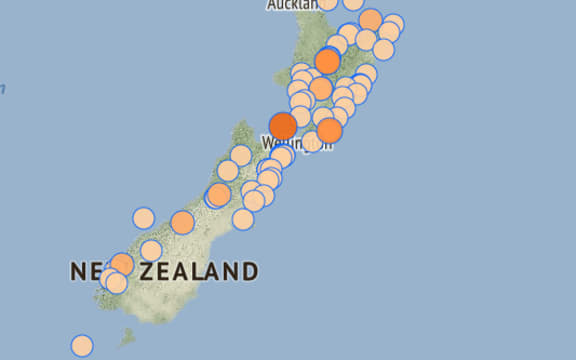When the heavens opened last weekend, some channels of official information closed. Emergency management agencies and the news media both copped criticism for lagging behind events - and behind social media feeds fed by citizens and ordered by algorithms.
Can the content from the crowd in real time be harvested for a big picture the news media and the authorities alike can all use?

Examples of the mobile tools the Prepare Wellington project proposed for crowd-sourcing information before and during an emergency. Photo: Prepare Wellington report
Among those self-identifying as a drongo this week - but only ironically to send up Auckland mayor Wayne Brown - was Stuff’s boss Sinead Boucher.
“They didn’t clock off at 7.30pm. They didn’t wait to be told it was an emergency. They worked all night even when their homes were threatened and their whanau were evacuated,” she said in a Twitter shout-out to “media drongos” who covered the floods.
Stuff reporter Kelly Dennett had compiled a revealing timeline which showed how communications channels were falling short. On The Front Page podcast, New Zealand Herald deputy editor Hamish Fletcher gave a vivid account from the newsroom about the night the heavens opened but official information sources closed up.
Some media - including RNZ and TVNZ - are deemed ‘lifeline utilities’ under emergency management rules and are obliged to keep broadcasting updates and emergency information no matter what.
But not all the media critics were satisfied with the media when the rain hit.
“I waited for someone to appear, pointing to a map of greater Auckland and saying ‘These areas are experiencing heavy flooding…State Highway 1 is closed here, here and here as are these arterial routes here, here, and here across the city,” said former Herald editor Gavin Ellis
He said he didn’t get much more on Saturday morning TV either. The two main channels’ weekend news shows are yet to screen in 2023 because of the way they are publicly-funded by NZ on Air for a set number of episodes per year.
Rolling coverage was offered by both TVNZ and Three/Newshub by Saturday afternoon. But even then, as Ellis noted, viewers were seeing almost as much social media material as live journalism or the official information that from some quarters was still in short supply.
At The Spinoff, Duncan Greive said the floods showed official communications can’t respond at the required pace in a crisis - and the major media institutions “appeared thinly staffed and failed to interrupt scheduled programming."
“Even on the Friday evening of a long weekend, we’re entitled to expect better,” he wrote.
One RNZ listener complained to Mediawatch that on the evening our biggest city was flooding, Country Life was on air as usual on RNZ National. (He may not be aware RNZ in Auckland had been evacuated in the middle of Checkpoint shortly before that.)
It remains to be seen whether those reviewing all the crisis communications and coverage of the emergency will consider if a better-funded public media entity doing TV, radio and online might offer more comprehensive and quicker coverage of a sudden crisis in future.
First port in a storm?

Flooded grounds after the rain storm at Eden Park's Outer Oval, Auckland, New Zealand on Wednesday 1 February 2023. Mandatory credit: Andrew Cornaga / www.photosport.nz Photo: Photosport
For years people turned first to the big and trusted names in domestic news in a domestic disaster.
But Grieve reckoned it was “user-generated smartphone coverage” that clarified how bad things were getting in real time when some emergency agencies and media were slow to react.
“While the mayor prevaricated over whether to declare a state of emergency, its citizens watched their phones in horror as Auckland drowned,” he wrote.
TikTok in particular “decisively won” the media coverage, he added.
“My own sources of information were pretty much social media as well - which I wouldn't have thought would be the case in the past,” Mark Jennings told Today FM last Monday.
Jennings was TV3’s long-serving news boss the first time local channels went into sustained rolling coverage of a domestic disaster. He went to Pike River co-ordinate the complicated coverage in 2010.
“If we look at where we're getting the best pictures, the fastest pictures and the actual localised knowledge that all of us in Auckland have been requiring, social media has been the fastest way to get it,” he said Monday.
It’s not news to emergency experts or other clued-in editors.
“Gaps in our response capability and capacity to keep pace with social media” were identified in the National Disaster Resilience Strategy / Rautaki ā-Motu Manawaroa Aituā published three years ago.
That also said a Ministerial Review two years before that identified “emerging issues such as maintaining pace with media and social media, responding to new and complex emergencies, and the type of command, control, and leadership required to ensure rapid, effective, inclusive, and compassionate response and recovery.”
Those ‘emerging issues’ all emerged starkly this past week.
Dan Neely is senior advisor in emergency preparedness at the Wellington Region Emergency Management Office - WREMO for short. He’s been there since 2009, and began setting up adopting social media accounts the following year.
“It made sense to us at the time to be able to have direct conversations with our communities in ways that were never possible before. The platforms are pitched towards different audiences and will continue to evolve. We learn . . . as those platforms continue to expand,” he told Mediawatch.
“Mainstream media news organizations, RNZ for example, are critical lifeline partners that are important during an emergency response. We also use those immediately. But platforms like Facebook and Twitter, TikTok can really provide live video and audio in feeds that are really focused - and that can be hugely useful to provide a perspective of what is happening really on the ground - and to validate what we're hearing,” he said.
But has that two-way immediacy also created the unrealistic expectation that emergency information will be available almost immediately from some sort of ‘Mission Control’ staffed by people in headsets 24/7? Even on anniversary holiday weekends after 7:30pm?
“People increasingly expect a certain degree of 24/7 information about everything. We're really conscious of keeping our messaging tied to emergency management - which means life and property safety - and not getting pulled into ‘inconvenience management’ - stuff like traffic delays and canceled events,” said Neely.
“A big part of our job is working closely with our partners and our team to rebroadcast what is relevant to people in the emergencies so that they can make good and timely decisions,” he said.
A big, shared, living picture

Tristan Sparks and Jo Bailey's crisis mapping project report. Photo: Massey University College of Creative Arts
While Ellis lamented the lack of a comprehensive map of closures, inundations and relief centres and danger areas, Jennings told Today FM a WhatsApp group of his street’s neighbours was “the best source of information” when disaster struck.
It’s not the same everywhere though. On Wednesday, New Lynn MP Deborah Russel said she had been in the houses of several stricken constituents who didn’t have smartphones or use the internet.
But can that sort of online local info be shared with authorities, media and citizens all at once?
Back in 2015, WREMO commissioned research into whether citizens and social media could be harvested to create ‘live crisis mapping’ - and preparedness.
Massey University design lecturer Tristam Sparks - with College of Creative Arts colleague Jo Bailey - led design for Prepare Wellington, a live platform which emergency management agencies, the media and citizens alike could all use.
The idea is to harvest information and images from mobile users with an app to create a kind of live crisis map which is ‘edited’ by emergency services and also available to news media.
To work, people need to be ‘onboarded’ with the app and prepared to use it before a crisis.

A map of earthquakes recorded by GeoNet on 22 September, 2022. Photo: Supplied/ GeoNet
Sparks says the popularity of GNS’s GeoNet app shows the willingness is there.
“One of the first things that most of us do when we hear or feel an earthquake is reach for our smartphones and submit a ‘felt it’ report,” he said.
GeoNet also creates content and advice for users, like its 2022 In Review published this week.
The Prepare Wellington proposal features templates for the users to submit geolocated damage reports and verify them.

Photo:
“I would say that social media definitely had the edge and has had the edge over traditional broadcasting for quite a while, especially in terms of news gathering,”Tristam Sparks told Mediawatch.
Algorithms that run the social media feeds to users are much more refined than when the quakes struck in Christchurch more than a decade ago, depending on the platform. Some approximate the sort of selection news media make.
“A social media algorithm will definitely pick up what's popular . . . but really not helpful in a crisis or even newsworthy,” he said.
“It's all very well for us to publish to a map but you want to be able to ensure what is actually happening. One way to do that is multiple reports. The other way is by Civil Defence and emergency services professionals who could be on the spot already. That verification is important," he said.
The report proposes a Social Media Initial Response Team (SMIRT) “where WREMO staff publish appropriate news to social media channels, and monitor online sources for information.”
This can be escalated to a Social Media Active Response Team (SMART) which “takes responsibility for gathering online information for situational awareness, and sharing pertinent information with the public through social media channels.”
“You need to know when enough reports come in from users are in a crisis situation, where it should be elevated and passed on to the emergency services. And all of this information will be available to journalists, and citizens as well, so that they would know whether they could help, or whether they should just steer clear. That could really help management of people in these already fraught situations," said Sparks.
While Prepare Wellington hasn't been created as the platform the creators proposed, WREMO says the findings and idea have been applied to the regions 172 Emergency Community Hubs.
The deluge in Auckland and neighbouring regions this past week showed thousands of people actively posted and shared reports of the crisis which they had witnessed - all of which helped create a bigger picture for social media users when official information was sparse.
It remains to be seen if the review into the communications shortfalls during Auckland's disaster considers a platform that could harvest citizens' information and their content to create a live crisis 'map' everyone could use - including news media.

